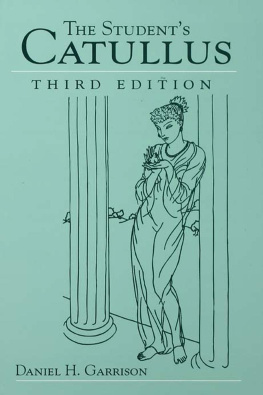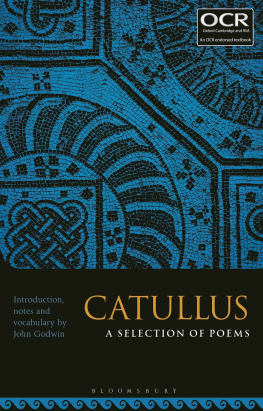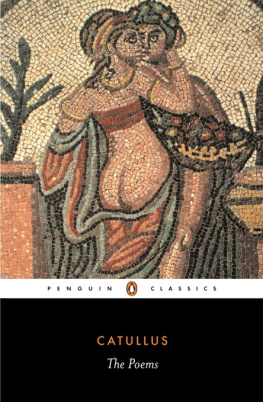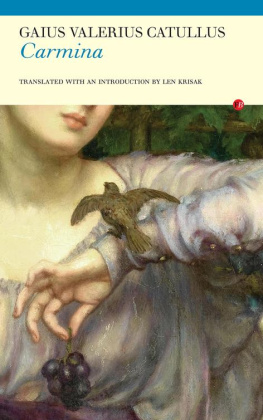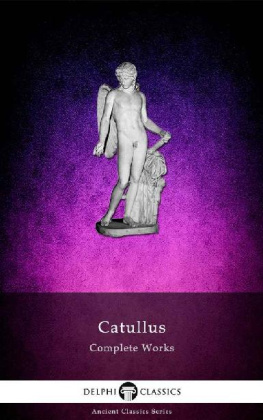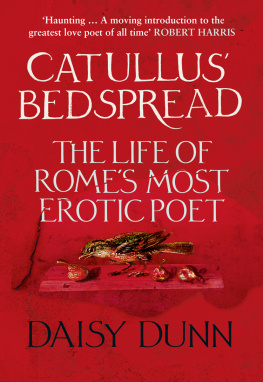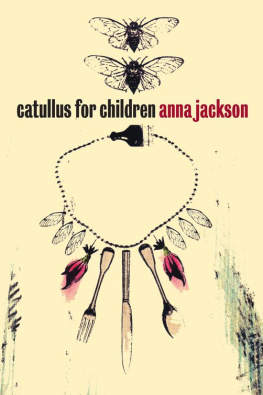The Student's Catullus
Oklahoma Series in Classical Culture
Series Editor
Ward W. Briggs, Jr., University of South Carolina
Advisory Board
Susan Guettel Cole, State University of New York, Buffalo
Carolyn J. Dewald, University of Southern California
Thomas M. Falkner, The College of Wooster
Elaine Fantham, Princeton University
Nancy Felson, University of Georgia
Helene P. Foley, Barnard College
Ellen S. Greene, University of Oklahoma
Sara Mack, University of North Carolina, Chapel Hill
Thomas R. Martin, College of the Holy Cross
John F. Miller, University of Virginia
Jon Solomon, University of Arizona
Richard F. Thomas, Harvard University
The Student's Catullus
Third Edition
Daniel H. Garrison
Department of Classics,
Northwestern University
Front cover illustration is from Horace Gregory, The Poems of Catullus, illustrated by
Zhenya Gray, by permission of Random House, Inc./Crown Publishers, Inc.
Maps IIV courtesy of The Cleveland Museum of Art.
First published in Great Britain in 1992
Second edition 1996
Third edition 2005
2 Park Square, Milton Park, Abingdon, Oxon, OX14 4RN
Routledge is an imprint of the Taylor & Francis Group
2005 Daniel H. Garrison
All rights reserved. No part of this book may be reprinted or reproduced or utilised in any
form or by any electronic, mechanical, or other means, now known or hereafter invented,
including photocopying and recording, or in any information storage or retrieval system,
without permission in writing from the publishers.
British Library Cataloguing in Publication Data
A catalogue record for this book is available from the British Library
1SBN 0-415-36826-X
CONTENTS
MAPS
Star map: The Lock of Berenice
PREFACE
This edition is specifically designed for students who are studying Catullus for the first time. The text is therefore a reading text (not a strictly conservative scholar's version), with readings that will interfere as little as possible with the poetry as a whole. The commentary is the result of my own encounters with the Latin text, enlightened by my students, the commentaries of Ellis, Merrill, Fordyce, Quinn, and Thomson, and as much of the current scholarship as I have been able to digest. Like the text, this commentary is meant to interfere as little as possible with the reading of the poems. It does not as a rule participate in scholarly controversies or promote specific judgments of literary value. Its chief purpose is to help readers over difficulties with the Latin, and to offer such help as unobtrusively as possible. Additional notes about Catullus literary and rhetorical craft help students understand the poet's artistry. To assist the reader further, the commentary is supplemented by end materials: a list of Catullan persons (), six maps, and a comprehensive lexicon of Catullan Latin. This package should allow any reader familiar with Latin basics to read Catullus with good understanding and to make reasonably informed judgments about the poetry he wrote.
For the conception of the book as a whole as well as a thoughtful critique that saved it from many errors before it went to press, I am much indebted to Marilyn Skinner; for numerous corrections and improvements, the anonymous referees of the University of Oklahoma Press; T. P. Wiseman; and Arthur Robinson. Professor Robinson also supplied the materials for . For funding to prepare the earliest version of this book, I am indebted to a grant from the President's Fund for Educational Excellence.
Daniel H. Garrison
Northwestern University
January 1989
PREFACE TO THE SECOND EDITION
In the six years that have passed since completing the first edition, I have made numerous additions and corrections, most of them suggested by my continuing classroom experience, some by the comments of reviewers and colleagues, and others by scholarly work that has appeared. In several instances, I have changed my mind about the interpretation of Catullus language; in others, I have corrected errors, clarified my language, and added new aids to the reader. This edition, while keeping to the same assumptions as the first, should be more useful to the student of Catullus, clearer, and more prescient in anticipating difficulties. Among the many people who have suggested improvements, I owe special thanks to Don Fowler, Arthur Robinson, David Traill, P. Walcot, and John Yardley. I am also indebted to Anne Garrison, who came out of editorial retirement to scrutinize the entire book sentence by sentence.
D.H.G.
January 1995
PREFACE TO THE THIRD EDITION
Two years after the second edition, two important new books on Catullus came to publication: Helena Dettmer's Love by the Numbers and D. E S. Thomson's large textual and interpretive commentary, which supplements a lifetime of work upon the text of Catullus poems. If proof were needed that this author continues to hold our attention at the turn of the millennium, the steady flow of critical studies and the strong position of Catullus in school and college curriculums is sufficient to justify a carefully rethought third edition. I continue to be indebted to my colleagues for their constructive suggestions, among them John Breuker, Jr., of Western Reserve, Helena Dettmer at the University of Iowa, Judith Hallett of the University of Maryland, and Michael Haslam of UCLA. Thanks are also due to Jennifer Cunningham, Associate Editor at the Press, who provided much-needed editorial correction of my revisions.
D.H.G.
May 2004
INTRODUCTION
Most of what is important about Catullus is in the poems he wrote. Chronology, identifications of persons, and other biographical details are often conjectural, and so open to dispute that all reconstructions of his life (including the one that follows) must be taken cum grano salis. It is generally believed that he was born about 84 B.C. and died young, in about 54. He came from a prominent family based in Verona, in what was then Cisalpine Gaul. Suetonius says his father was a frequent host of Julius Caesar, a relationship that may have begun during the latter's governorship of that province. Though Catullus went to Rome early in his adult life, his poems show a deeply emotional attachment to his first home.
Catullus poems are so vividly emotional that since antiquity students of his work have tended to read them as a record of his personal life. Though this biographical tendency is probably justified to some extent, the tradition in which Catullus wrote called instead for the artful projection of an image or persona, literally a mask behind which the poet manipulates the tools of poetic rhetoric. Catullus achievement lies in his seamless transformation of actual experience into poetic fiction that is at once audacious and believable. No one reading his poems today can tell where self-revelation gives way to invention.
There is no need to decide between a biographical reading of Catullus and one that assumes everything in the poems is literary invention. Whether as personality or


